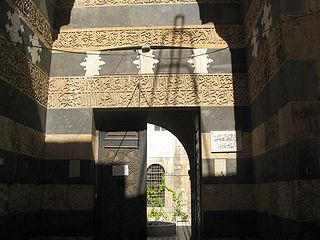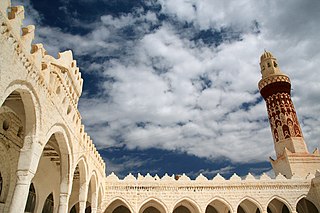
Taiz is a city in southwestern Yemen. It is located in the Yemeni Highlands, near the port city of Mocha on the Red Sea, lying at an elevation of about 1,400 metres (4,600 ft) above sea level. It is the capital of Taiz Governorate. With a population of over 600,000 in 2005, it is the third largest city in Yemen after the capital Sana'a and the southern port city of Aden.

Islamic Cairo, also called Historic Cairo or Medieval Cairo, refers generically to the historic areas of Cairo, Egypt, that existed before the city's modern expansion during the 19th and 20th centuries; particularly the central parts around the old walled city and around the Citadel of Cairo. The name "Islamic" Cairo refers not to a greater prominence of Muslims in the area but rather to the city's rich history and heritage since its foundation in the early period of Islam, while distinguishing it from with the nearby Ancient Egyptian sites of Giza and Memphis. This area holds one of the largest and densest concentrations of historic architecture in the Islamic world. It is characterized by hundreds of mosques, tombs, madrasas, mansions, caravanserais, and fortifications dating from throughout the Islamic era of Egypt. In 1979, the United Nations Educational, Scientific and Cultural Organization (UNESCO) proclaimed Historic Cairo a World Cultural Heritage site, as "one of the world's oldest Islamic cities, with its famous mosques, madrasas, hammams and fountains" and "the new centre of the Islamic world, reaching its golden age in the 14th century."

The Citadel of Cairo or Citadel of Saladin is a medieval Islamic-era fortification in Cairo, Egypt, built by Salah ad-Din (Saladin) and further developed by subsequent Egyptian rulers. It was the seat of government in Egypt and the residence of its rulers for nearly 700 years from the 13th to the 19th centuries. Its location on a promontory of the Mokattam hills near the center of Cairo commands a strategic position overlooking the city and dominating its skyline. At the time of its construction, it was among the most impressive and ambitious military fortification projects of its time. It is now a preserved historic site, including mosques and museums.

Al-Ṭayyib Abū'l-Qāṣim ibn al-Manṣūr was, according to the Mustaali sect of Isma'ilism, the twenty-first Imam and the last Caliph of the Fatimid Caliphate. Abul-Qāṣim was the son of the twentieth Fatimid Imam, al-Amir bi-Ahkami'l-Lah, who ruled Egypt from 1101-30. He was born in Cairo on Sunday, March 16, 1130 and was 2 years 7 months old when his father, al-Amir, was assassinated in the night of Thursday, October 15, 1132. Tayyib was reported to be about two years old at the time of al-Amir's assassination. Al-Hafiz was appointed representative Caliph on behalf of Imam Al-Tayyib. Later al-Hafiz declared himself as Imam and Caliph in 528 AH/1134 AD and Al-Tayyib was taken into hiding.

Jiblā is a town in south-western Yemen, ca. 8 kilometres (5.0 mi) south, south-west of Ibb. It is located at the elevation of around 2,200 metres, near Jebal Attaker. The town and its surroundings were added to the UNESCO World Heritage Tentative List due to its purported universal cultural value. Historical Palace of Queen Arwa is located in the town.

Arwa Al-Sulayhi, full name Arwā bint Aḥmad ibn Muḥammad ibn Jaʿfar ibn Mūsā Aṣ-Ṣulayḥī Al-Ismāʿīliyyah was a long-reigning ruler of Yemen, firstly as the co-ruler of her first two husbands and then as sole ruler, from 1067 until her death in 1138. She was the last of the rulers of the Sulayhid Dynasty and was also the first woman to be accorded the prestigious title of Hujjah in the Isma'ili branch of Shia Islam, signifying her as the closest living image of God's will in her lifetime, in the Ismaili doctrine. She is popularly referred to as As-Sayyidah Al-Ḥurrah, Al-Malikah Al-Ḥurrah (Arabic: ٱلْمَلِكَة ٱلْحُرَّة or Al-Ḥurrātul-Malikah, and Malikat Sabaʾ Aṣ-Ṣaghīrah.

The Az-Zahiriyah library or Madrasa al-Zahiriyya is a historic library, madrasa, and mausoleum in Damascus, Syria. It dates back to 1277, taking its name from Sultan al-Zahir Baybars (1223–1277) who is buried here.

Islam came to Yemen around 630 during Muhammad's lifetime and the rule of the Persian governor Badhan. Thereafter, Yemen was ruled as part of Arab-Islamic caliphates, and became a province in the Islamic empire.

Al-Muizz li-Din Allah al-Fatimi Street, or al-Muizz street for short, is a major north-to-south street in the walled city of historic Cairo, Egypt. It is one of Cairo's oldest streets as it dates back to the foundation of the city by the Fatimid dynasty in the 10th century, under their fourth caliph, Al-Mu'izz li-Din Allah . Historically, it was the most important artery of the city and was often referred to as the Qasaba. It constituted the main axis of the city's economic zones where its souqs (markets) were concentrated. The street's prestige also attracted the construction of many monumental religious and charitable buildings commissioned by Egypt's rulers and elites, making it a dense repository of historic Islamic architecture in Cairo. This is especially evident in the Bayn al-Qasrayn area, which is lined with some of the most important monuments of Islamic Cairo.

Bayn al-Qasrayn is the district and plaza between two former palace complexes constructed in the 10th century by the Fatimid dynasty in medieval Islamic Cairo, within present day Cairo, Egypt. It was an original element in the Fatimid Caliphate's plan for a new palace-city, named al-Qahirah, and later became the site of many monumental buildings constructed in the Ayyubid, Mamluk, and Ottoman periods, even up to the 19th century. Many of these structures from different periods survive in the area today, located along what is now called al-Mu'izz Street.
The Sulayhid dynasty was an Ismaili Shi'ite dynasty established in 1047 by Ali ibn Muhammad al-Sulayhi that ruled most of historical Yemen at its peak. The Sulayhids brought to Yemen peace and a prosperity unknown since Himyaritic times. The regime was confederate with the Cairo-based Fatimid Caliphate, and was a constant enemy of the Rassids - the Zaidi Shi'ite rulers of Yemen throughout its existence. The dynasty ended with Arwa al-Sulayhi affiliating to the Taiyabi Ismaili sect, as opposed to the Hafizi Ismaili sect that the other Ismaili dynasties such as the Zurayids and the Hamdanids adhered to.

The Ancient City of Aleppo is the historic city centre of Aleppo, Syria. Before the Syrian Civil War, many districts of the ancient city remained essentially unchanged since its construction during the 12th to the 16th century. Being subjected to constant invasions and political instability, the inhabitants of the city were forced to build cell-like quarters and districts that were socially and economically independent. Each district was characterized by the religious and ethnic characteristics of its inhabitants.
Ali bin Muhammad bin Ali al-Sulayhi was the founder and sultan of the Sulayhid dynasty in Yemen. He established his kingdom in 1047 and by 1063, the Sulayhids controlled had unified the entire country of Yemen as well as the Muslim holy city of Mecca under his leadership. Al-Sulayhi was killed in 1066 during a tribal vendetta between the Sulayhids and the Najahids of Zabid. He was succeeded by his son, Ahmad al-Mukarram.

The Zurayids, were a Yamite Hamdani dynasty based in Yemen in the time between 1083 and 1174. The centre of its power was Aden. The Zurayids suffered the same fate as the Hamdanid sultans, the Sulaymanids and the Mahdids, since their lands were taken over by the Ayyubids, and they themselves were liquidated. They were a Shia Ismaili dynasty that followed the Fatimid Caliphs based in Egypt. They were also Hafizi Ismaili as opposed to the Taiyabi Ismaili.
The following is a timeline of the history of the city of Sana'a, Yemen.

Madrasa and Mosque of Al-Ashrafiya or Ashrafiya Mosque is a historical madrasa-mosque in the old part of the city of Taiz, Yemen. It is located at the foot of Mount Sabr in the southwestern part of the city in a neighborhood named Ashrafiya. It was built in 1275 and opened in 1382 by Sultan Ashraf Ismail bin Abbas of Rasulid dynasty. In addition to the prayer hall, the mosque is attached with a madrasa and the shrines of a number of the Rasulid sultans. It is considered as one of the two most beautiful mosques in Taiz, along with Mudhaffar Mosque, and one of the most important centers in Islamic history of Yemen.

The Mosque of Queen Arwa bint Ahmad Al-Sulayhi, simply the Queen Arwa Mosque Arabic: مَسْجِد ٱلْمَلِكَة أَرْوَى بِنْت) أَحْمَد ٱلصُّلَيْحِي, romanized: Masjid Al-Malikah Arwā bint Aḥmad Aṣ-Ṣulayḥī), is a historical mosque in Jibla, Yemen. It was built between 1056 to 1111 CE by Queen Arwa al-Sulayhi and her tomb had later became the site of pilgrimage. It retains its importance as one of the oldest ancient Yemeni mosques. It is also known as Hurrat-ul-Malaika Mosque, as the queen was often referred as Al-Malika Al-Hurra, which means "The Noble Queen".

Jennad Mosque is an ancient mosque located 20km southwest from Taiz, Yemen. It is considered the oldest surviving and the first mosque in Yemen built during the beginning of Islam, established by Muadh ibn Jabal who was sent by the Islamic prophet Muhammad to Yemen to teach its people and the provisions regarding the religion and spend among them in accordance with Sharia in the year 6 AH. As such it is one of the most important religious sites in Taiz governorate. It is also known as Mu'adh Mosque.

Kasbah Mahdiyya is a kasbah located near the city of Kenitra, Morocco. It is situated at the downstream of Sebou River in the vicinity of the Atlas Mountains, 12km from the city of Kneitra. The kasbah was built during the era of Almohad sultan Abd al-Mu'min, and restored during the Alaouite period in the 17th century.
The Great Palaces of the Fatimid Caliphs were a vast and lavish palace complex built in the late 10th century in Cairo, Egypt, to house the Fatimid caliphs, their households, and the administration of their state. There were two main palace complexes, the Eastern and the Western Palace. They were located in the center of the walled city of Cairo around the area still known today as Bayn al-Qasrayn.



















